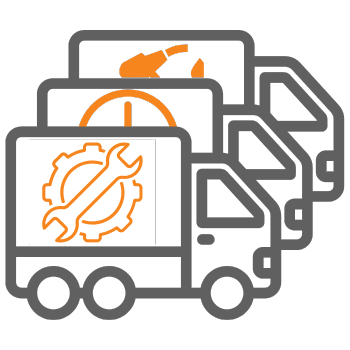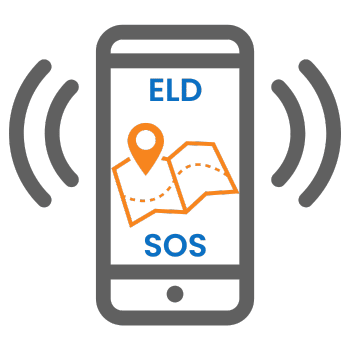Bluetooth Technology
Bluetooth technology is revolutionizing the way businesses are able to manage their resources and assets by providing short-range communication between IoT devices which have been paired. To begin to grasp the scope of what’s coming, it is estimated that 334 billion Bluetooth enabled devices will ship by 2027.
This article delves into the current trends and potential future developments in integrating this technology with telematics. It aims to provide insights into how these advancements can improve fleet asset management and tracking across various industries.
What is Bluetooth Technology?
Everyone is familiar with wireless earbuds which use Bluetooth technology. BT technology is a specific patented technology which is generally secure due to pairing, encryption, and short range. It is also inexpensive which allows it to be installed in many IoT devices and used in a wide variety of applications.
Originally, Bluetooth was a one-to-one connection. With the introduction of Bluetooth 5.4 there is now bi-directional support for one-to-many connections. With BT 5.4, thousands of nodes can be connected. An example of this might be electronic labels in a grocery store. Taking inventory of what is on the shelf might be done with a BT reader simple passing down the aisle, while in the old days, a person had to count every item, on every shelf.
In a telematics application, this may facilitate the programming of multiple GPS trackers at one time. What once took hours to do might take minutes with multiple simultaneous connections. It can now provide valuable data analytics, leading to better decision-making and operational efficiency.
This technology continues to evolve, integrating with more systems to offer comprehensive solutions. This progression ensures that businesses can optimize asset usage and significantly reduce losses.

Common Bluetooth Applications with Telematics
Telematics is a method of monitoring motorized assets. Telematics combines a variety of data sources to increase visibility on how a vehicle is driven, how it is operating, and potential mechanical issues. Data may come from GPS tracking, OBD II or CAN-BUS, fuel tank level sensors, accelerometers, speedometers, and more. Every monitored computer and sensor on a vehicle are included in the term telematics.
In some fleet applications there is a need to monitor systems, devices, or mechanisms which are not part of the OEM monitoring data set. One example of an important variable is the up and down motion of a garbage truck lift arm which indicates service has been provided. The lift arm may not have a sensor installed by the truck manufacturer, but it needs to be monitored.
To do this, an accelerometer can be attached to the arm and each time it lifts past a certain point, it logs the data. This data is then transferred via Bluetooth signal to a telematics device. The telematics device then transmits it with GPS tracking data and other data to a database. The database is then accessed by a customer via a web portal.
Another common Bluetooth application is cargo container tracking or roll door tracking. A Bluetooth sensor inside a magnetic contact switch can be placed on a shipping container or truck roll door. When the door opens, the magnetic switch breaks contact and sends the data via Bluetooth to the telematics device. In this scenario the telematics device is a solar powered GPS tracker using satellite communication.
There are many Bluetooth devices available. If there is a commercial application where money can be made, someone has created a Bluetooth sensor. Telematics devices such as Fleetistics ONE and Geotab devices can connect to many sensors giving fleet managers a lot of flexibility and new insights. One customer managing commercial water pumps uses this technology to get alerted when a pump stops pumping. This is important because a pump may be pumping water at a construction site or pumping sewage during a maintenance period, and the need to know if it stops is critical.
Bluetooth Devices Currently Available for Telematics Applications
- Magnetic contact sensor
- Cold chain temperature
- Fuel level
- Proximity
- Vibration detection
- Card reader
- Data transport
- Ambient temperature
- Light detection
- Distance
- Mesh networks
Key benefits include:
- Enhanced real-time data collection
- Improved asset location accuracy
- Greater energy efficiency
- Reduced operational costs
- Seamless integration with existing systems

Power Consumption
A key feature of Bluetooth is low power consumption. BLE or Bluetooth Low Energy is another version of the technology. Nothing can be monitored or transmitted without power, so it follows that low power consumption is very important in practical applications. Consider ear buds or hearing aids and imagine the size of the battery needed to fit in such a small device.
As devices scale up, larger batteries can be used to extend the power life from hours to months or even years. Engineers and developers work hard to find a balance between performance, battery size, and power consumption. Back to the ear buds/hearing aids example, recharging or changing batteries every day or two is not such a big issue, but in a fleet application, that is far too frequent.
Through extensive testing and field trials, IoT manufacturers using Bluetooth technology are refining device performance to meet particular industry needs. Devices can now run longer on a single charge due to lower power consumption. This advancement is crucial for businesses with extensive asset inventories.
Furthermore, energy-efficient designs contribute to sustainability goals. They help minimize electronic waste and reduce environmental impact.
Overcoming Challenges in Bluetooth Technology
Bluetooth offers significant benefits, but it also presents some challenges to be overcome. Signal interference and physical barriers can disrupt the smooth flow of data. These issues can lead to inaccurate location data and inefficiencies. To combat interference, developers are exploring technologies that enhance signal strength and reliability. These improvements ensure more accurate data even in challenging environments.
Training staff to use these advanced systems effectively is essential. Without proper training, the full potential of these systems may not be realized.
The integration of Bluetooth solutions with your existing platforms can also present difficulties. Companies need to take steps to ensure systems are compatible to achieve seamless operations and information flow. Your Fleetistics Account Manager can point you to Bluetooth integrations that are designed to work with your current telematics.
Improving Indoor Positioning and Geofencing
Indoor positioning is vital for precise asset tracking within buildings. Current systems are improving their accuracy to better serve industries like retail and healthcare. Refinements in technology allow for precise indoor location tracking. This enhances resource allocation and customer experience in confined areas.
Geofencing creates virtual boundaries. When assets move beyond these limits, alerts can be triggered, offering an additional layer of security and control.
The Role of Bluetooth Technology in Various Industries
Bluetooth technology finds its place across diverse industries, enhancing operations and resource management. Each sector leverages this technology uniquely to resolve specific challenges.
In healthcare, it’s used to track medical equipment, ensuring availability when needed. Quick access to devices can improve patient outcomes and streamline hospital operations.
Retailers utilize Bluetooth technology for inventory management, reducing stock discrepancies and improving the shopping experience. Real-time data helps retailers align stock levels with consumer demand more effectively.
Manufacturing sectors benefit from Bluetooth technology by tracking assets throughout production. This reduces downtime and boosts efficiency, leading to enhanced productivity.
In logistics, the ability to monitor goods during transit provides security and transparency. Bluetooth tracking ensures cargo safety from point of origin to final delivery.
Integrated with telematics for industries operating fleets of vehicles, more and more possibilities come to mind.
- Are all the tools & equipment needed or products to be delivered loaded on the truck?
- Are tires inflated to the proper pressure?
- Proximity beacons can establish proof of service when attached to things like refuse bins.
- How many times was the roll up door opened/closed?
- Was something important left behind?

Conclusion: The Future of Bluetooth Technology Integrations with Telematics
The future of Bluetooth is bright and full of promise. It will evolve with technological advancements, bringing new capabilities to diverse industries. Integration with blockchain technology is anticipated to enhance security and transparency. This innovation will address data integrity and authentication concerns.
Smart cities are likely to rely heavily on Bluetooth asset tracking. Intelligent infrastructure will use this technology to manage resources more effectively. Global events, including pandemics, have accelerated the adoption of various tracking solutions. Businesses need to adapt quickly, driving technological innovation. As industries embrace these changes, Bluetooth will play a critical role in operational efficiency. Staying informed about these trends is vital for any organization looking to remain competitive.
In short, the future is very bright. Bluetooth technology continues to expand and encompasses more and more applications that enhance business operations and reduce operating costs for a low investment. Enhancements in the last few years have opened new markets for low cost and large volume applications such as grocery store shelf pricing labels or cattle location and health data.
The evolution of Bluetooth technology is inevitable. It promises more efficient and secure asset management across industries. Embracing these advancements means staying ahead in a competitive market. Businesses that adapt quickly will benefit from increased efficiency and cost savings.










